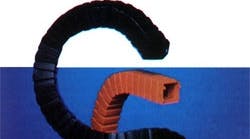Many industrial cables and hoses transmit energy from fixed sources to machine mechanisms in linear motion. They may need to be guided and protected from external stresses common to the manufacturing environment. Cable and hose carriers can do it — if you pick them right. Carriers by most suppliers come in a range of minimum bend radii, and they control bending of the conduits they protect, particularly in linear-motion applications. Carriers also keep conduits from getting caught on obstructions. Also, many carriers are of closed, tube-type design, which provides further protection from weld spatter, hot metal chips from machining, and abrasive materials. Thus, carriers can prevent conductor breakage, entanglement, and wear. Applications range from sawmill carriages and truck-wash gantries to injection-molding robots and computer plotter print heads.
Strength vs. size
Strength is important — the carrier must withstand the acceleration forces that the moving mechanism imposes. Strength-related factors include:
• Total conduit weight, including filled weight of the hoses.
• Length of run.
• Maximum unsupported span.
• Maximum acceleration rate.
Carrier suppliers can help determine the load limit and select the right carrier.
However, many carriers are mistakenly selected on size. Though it is true that the conduits must have a certain amount of room to move within the carrier, this factor is secondary. Some manufacturers make several grades of carriers within a given size range. Selecting a light-duty carrier for a high-acceleration application might cause carrier damage and machine downtime. Conversely, a heavy-duty carrier for a low-stress application is poor economy.
You should first analyze the specifications of your cable or hose configuration — such as acceleration rate and length of run — with a carrier supplier’s help if needed, to determine load limitations.
Need for separators
Another common problem is conduit tangling and abrading. As the carrier reciprocates thousands of times, smaller conduits tend to work their way between larger ones. Cables of different cross sections have different bending characteristics. If cables and hoses are placed in a carrier randomly, they will almost surely interfere with one another, eventually causing conductor breakage, accelerated jacket wear, or both.
The solution: Install separators in the carrier. Put cables of different cross sections and diameters in separate compartments, and segregate hoses from cables altogether. Some manufacturers offer flexible systems of vertical separators and horizontal shelves to let you customize the carrier interior layout. Less flexible systems require custom-ordered separators for a specified conduit layout. They may not accommodate alternative arrangements you might want later.
Some carrier designs are inherently more “cable-friendly” than others, with interiors carefully designed to minimize pressure points and abrasion. Moreover, carriers with easy-open crossbars or covers let you inspect conduits more frequently and replace them more easily. Choose a specific interior design based on carrier type and number and variety of conduits. Whenever possible, follow the supplier’s recommendations for separation components, including plastic crossbars and divider elements.
Choose the right conduit
For any demanding linear-motion application, the conduit itself must withstand the external stresses of its environment. For example, most electrical cable is not designed to handle the constant tensile, compressive, and shear forces that carriers impose.
Continuous bending causes most cables to “corkscrew” — a major cause of conductor breakage. The spiral twist may entrap other cables, damaging them as well. The cable’s interior structure should be specially designed with isolated conductors to counteract the corkscrew effect. Also, cable jacket material must be highly abrasion resistant and slick enough to slide easily against other cables and against the carrier itself. Few cables are designed for carrier applications, but your extra effort to select the most “carrier-friendly” cable will pay for itself many times over in longer life.
Support and containment
Failure to support and guide the carrier in long travel applications is another common problem. Carriers are designed for unidirectional linear motion; side lids aren’t intended to withstand side forces. Where a metal carrier doubles back on itself, such as in center-mounted installations, don’t let the upper run drag on the lower run, or the carrier will quickly saw itself to pieces. For the upper run, use a system of rollers.
For such applications, you should evaluate plastic carriers. They have a much lower coefficient of friction, and you can let them glide on top of themselves. A simple trough can guide the carrier, but the risk of carrier damage is minimal either way. Plastic carriers also weigh less than metal carriers, further reducing the potential for serious abrasion.
The future. Carriers for tomorrow’s factories will have to travel farther and accommodate higher acceleration rates. Demanding applications will require more customization and in-depth analysis of available carrier types. You must be ready to know more; a successful linear-motion carrier application will depend more than ever on your knowledge of exactly what products suppliers offer.



